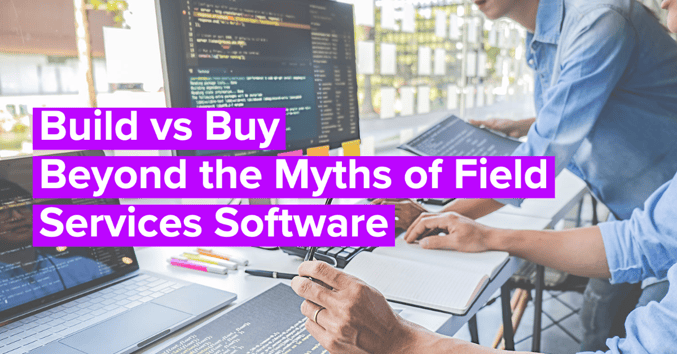Build vs Buy: Beyond the Myths of Field Services Software
Posted by Alloc8, Wed, Aug 4, 2021

In field services, the software you rely upon makes or breaks your future.
The right software takes you beyond managing your mobile workforce—and helps you empower them for growth and profitability.
For mobile workforces—that software is Alloc8.
But it can be tempting to try to build your own software—especially with recently announced government tax incentives sweetening the medicine for those prepared to invest huge time and money in an on-premise build.
Myths about the advantages of on-premises software—and supposed disadvantages of pre-built Software as a Service (SaaS)—have spread like wildfire. Software developers are always ready to charge for their time—they know that once you start developing software, it’s very hard to finish.
Let’s look at the myths of build vs buy.
The customisation myth.
In theory, building your own software gets you fully customised functionality—and that works best for your business. In this myth, SaaS software falls short—it does most of what you need, but won’t meet all your needs.
But reality tells a different story.
The biggest appeal of custom-built software is that it’s made to satisfy all your unique requirements. But it's an illusion—time and cost constraints mean features have to be prioritised—which means sacrificed.
Even if you could build everything you want for everyone in the business—you’d end up with a clunky, overly complex solution, designed around legacy business processes. In building what you want, you miss out on what you need.
SaaS solutions are built on global best practices. At Alloc8, our tools are stress-tested and based on decades of best practice, aggregated from industries and providers. Our solutions go beyond the vision of any in-house software team—and take you where the industry’s going, not where it’s been.
“When you start a project, the software you’re ‘going to build’ always sounds better than the software that already exists—because you can’t imagine the engineering limitations you’re about to run into”, says George Khreish, Alloc8 CEO.
The cost myth.
In theory, building software on-premise is a one-off cost—you can spend big, spend once—and know exactly where it ends, with tax rebates factored. In this myth, SaaS offers a low subscription, but no end date or guarantee on pricing
But reality tells a very different story.
Two words ring through the ears of anyone who’s ever done built on-premise software builds—scope creep.
Ask any development team—at least any not trying to land your contract—and they’ll advise you to double your budget for unexpected hurdles. If a build project estimate is $2M, get ready to spend $4M once the bugs appear—or lose your investment in the wind.
Even then—a double budget might not get it done. Despite best intentions, the ‘quick build’ will always get tricky and blow out any decent budget. You’ll also foot the bills of upgrades, maintenance and support costs—on your own. And the tax breaks designed for big corporations can get pretty cumbersome when budgets blow out so badly.
SaaS software like Alloc8 is built, tested and ready to use. Subscription is low cost because it distributes cost—so you pay a fraction of the price to access the entire system—instantly.
SaaS also gives you scalability. You grow when you want to, and develop when you need to—with the huge expense of coding the necessary ‘multi-tenant architecture’ completely covered.
And you don’t pay for anything that goes wrong. With Alloc8 your costs are fixed. Your monthly subscription covers upgrades, maintenance and support —everything’s included. There are no financial unknowns—and nothing to worry about.
“Only build if you don’t have a choice”, says George Khreish, “and even then watch out—even companies who actually finish building their own software often can’t afford to maintain it”.
The time-to-market myth.
In theory, building on-premises software is like any other project—and your field services experience helps you manage the calendar curve balls and hit your timelines. In this myth, SaaS users spend time and money setting up new systems.
But again—reality tells a different story.
On-premise software development doesn’t just blow out your budget—it blows up your calendar. Bugs and fixes, scope change and creep, developer error and turnover, briefing issues and process change—it all comes out in software development.
The more troubles you run into, the more precious time and resources you tie up fixing them. And with developers being paid by the hour, it’s easy to see how these projects are routinely underestimated to the tune of 3x or 4x.
Even if you can foot the bills, even if you do get a working version of the software—don’t expect a smooth transition or uptake. In fact implementation and onboarding of on-premises software typically takes at least 6 months—and sometimes longer.
Bugs, security issues, workarounds—they all warp original plans. So you’ll be adapting your office and field practice to unexpected processes, designed more for glitches and gremlins than for any best practice. And because the software is just yours, there’ll be zero online.
You’ll be on your own—and so will your workers.
Getting started with Alloc8 takes a few hours—a few days for the slower. We’ve invested heavily in onboarding and integrations so you launch simply—and get back to work fast.
Alloc8’s intuitive and easy to use. Our team is on-hand to help—that’s after a free demo to make sure it’s right for you—and before you pay anything.
Build smart, not hard.
On-premise software builds can sound good—but only in theory.
Reality always tells a different story.
Alloc8 gives your field service business full flexibility—without the burden of huge build and maintenance costs.
Alloc8 is affordable, easy to use, and scales as you grow—so you have time, money and resources to focus on your core business.
It’s time to move to the SaaS side.
Get in touch to schedule a free demo—and work the future with Alloc8.
Topics: workforce scheduling tool, workforce scheduling tips, workforce scheduling software, workplace safety, alloc8, technology, health and safety, workforce management